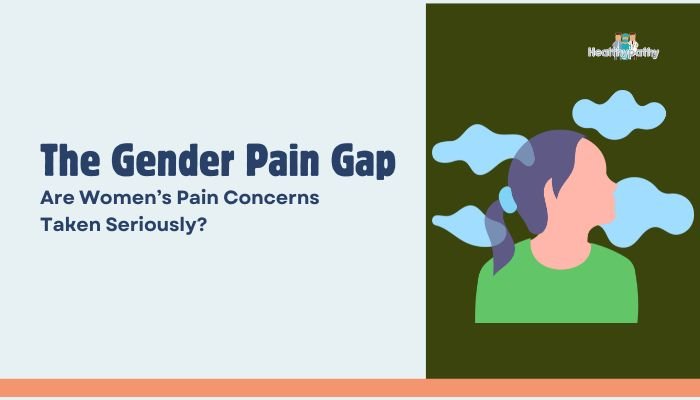Introduction
When women report pain—be it chronic backache, pelvic discomfort, or migraines—their complaints sometimes draw less urgency, fewer thorough investigations, or delayed treatment compared to men’s. This phenomenon, known as the gender pain gap, highlights how biases and societal norms can lead healthcare professionals to downplay or misinterpret women’s discomfort.
As a result, many conditions go underdiagnosed or undertreated. This article delves into the historical factors behind the gender pain gap, its real-world implications, and actionable steps toward more equitable care.
Understanding the Gender Pain Gap
What Is the Gender Pain Gap?
The gender pain gap references the documented trend where women’s pain is perceived as less severe, more “emotional,” or less credible compared to men’s accounts of pain. While not universally true in every scenario or health system, data and patient experiences repeatedly confirm that women, on average, encounter:
- Longer wait times for pain medication in emergency settings.
- Dismissal of pain as “all in their head.”
- More frequent misdiagnoses or delayed recognition of serious conditions.
Cultural and Societal Influences
Traditional stereotypes—like assuming women are more “emotional”—intersect with medical training that historically used male-focused research. These biases may prime healthcare providers to second-guess or minimize women’s complaints, even if unintentionally.
Contributing Factors to the Gap
Historical Lack of Female Representation in Clinical Trials
For decades, clinical trials centered on male participants, limiting understanding of how conditions or medications present in women. This leads to under-informed diagnostic criteria or treatments that don’t account for gender-based nuances.
Stereotypes About “Hysteria”
Historically, the term “hysteria” was used to label perceived female emotional instability. Echoes of that stigma persist today, making it more likely that a woman in pain is dismissed as anxious, depressed, or overly emotional, rather than exploring organic causes first.
Inconsistent Medical Training
Not all medical curricula robustly address women-specific pain issues—like endometriosis or vulvodynia. Lacking thorough knowledge, clinicians might under-recognize such conditions, leaving symptoms unvalidated and untreated.
Implicit Bias in Healthcare
Unconscious attitudes or beliefs can shape how doctors weigh symptoms, leading them to interpret women’s pain as less acute or consider it psychosomatic. Even well-intentioned providers may inadvertently contribute to these patterns.
Real-World Consequences
Delayed Diagnosis
Conditions like endometriosis, heart disease in women, or autoimmune disorders often go underdiagnosed. This not only prolongs discomfort but raises the risk of more severe complications.
Diminished Trust in Healthcare
Repeated dismissal or invalidation erodes women’s confidence in seeking professional care. Some may forgo further medical input entirely, fearful they’ll be labeled “dramatic” or told nothing’s wrong.
Emotional and Mental Strain
Chronic pain already strains mental health. Add to that the frustration or self-doubt from not being believed, and women can experience heightened stress, anxiety, or depression.
Steps Toward More Equitable Pain Management
Empowering Patients
- Self-Advocacy: Encourage women to track symptoms meticulously, present consistent logs, and ask for second opinions if concerns aren’t being addressed.
- Access to Information: Educate yourself on possible conditions, treatments, or labs to request, narrowing knowledge gaps.
Training Healthcare Providers
Medical institutions increasingly integrate gender-specific curricula. Repetitive emphasis on empathic listening, as well as practical training for female-centric conditions, can reduce bias.
Diverse Research Participation
Enrolling more women in clinical trials ensures that drug efficacy and side effects reflect the female population. Incentives or targeted recruitment can bring underrepresented groups into study populations.
System-Level Reforms
Healthcare systems must adopt policies ensuring pain assessment is approached systematically—like using standardized scales for all patients. Encouraging accountability in providers who repeatedly neglect or trivialize female pain is also crucial.
Navigating Pain Discussions as a Patient
Be Specific and Document
Describing pain in detail—location, frequency, intensity, triggers—helps providers understand it better. Keep a pain journal or use apps to note patterns over time.
Seek Support
Bringing a friend or family member to appointments can ensure your concerns are voiced and validated. If one doctor dismisses your worries, looking for a second opinion or a specialist (e.g., pain management, gynecology) may prove vital.
Stay Persistent
If you suspect an underlying condition remains unrecognized, politely but firmly request additional tests or referrals. Early intervention can be life-changing, so trust your instincts about your body.
Conclusion
The gender pain gap is rooted in historical biases, inconsistent research, and lingering stereotypes. Yet as awareness grows, both patients and healthcare professionals can counter these disparities through education, rigorous research, and systematic policy changes. Women should feel empowered to advocate for themselves—logging symptoms, questioning dismissals, and seeking providers who champion thorough evaluations. With enough progress, the healthcare field can ensure that all patients, regardless of gender, receive timely, compassionate, and evidence-based relief from pain.
References
- Hoffman DE, Tarzian AJ. The girl who cried pain: a bias against women in the treatment of pain. J Law Med Ethics. 2001;29(1):13–27.
- Institute of Medicine (US). “Women’s Health Research: Progress, Pitfalls, and Promise.” 2010.
- Goyal MK, et al. Racial and gender disparities in analgesic use in US EDs. Pediatrics. 2015;136(4):1–6.
- National Pain Report: Women’s experiences with pain management. 2021.






